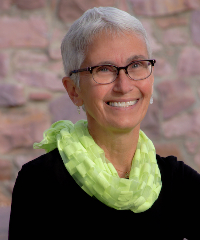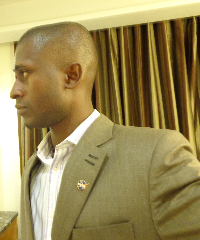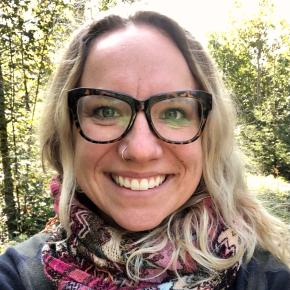Community Blogs
Community Blogs
Discover how the GLOBE community is engaging in all things GLOBE through the community blog posts below.
Learn how to create a GLOBE community blog post.
Filter By:
Blogs List
Hypothesis: It is expected that most mosquito larvae will be present in alkaline water with the highest pH while the least mosquito larvae in the acidic water with low pH.
Setup: 5 identical buckets were placed in a shaded area in my backyard, several meters from each other. The independent variable in this case was the pH of the water as it varied from strongly acidic to strongly alkaline. The exact values of pH used were 1, 3, 7, 10 and 12. These were achieved by adding baking soda and lemon to 500ml of distilled water. The number of larvae were observed every 5 days after which ...
Read More »
Posted in:
GLOBE Science Topics:
EARTH AS A SYSTEM
EARTH SYSTEM SCIENCE
Investigation Areas:
EARTH AS A SYSTEM
MOSQUITOES
Primary Audience:
STUDENTS
TEACHERS
Student Research Reports:
INTERNATIONAL VIRTUAL SCIENCE SYMPOSIUM REPORT
MISSION MOSQUITO REPORT
In this experiment, I will be exploring how geoposition, type of bait, and container size influence female mosquitos’ choice of where to lay their eggs.
Experimental design
There will be a total of 5 traps. Three of the traps will be positioned at a location near my house. They will be separated by a reasonable distance in the same type of environment to minimize the experimental error caused by having multiple breeding habitats in close proximity. The other two traps will be positioned in various locations in my land cover area of interest. The exact locations will be ...
Posted in:
GLOBE Science Topics:
EARTH AS A SYSTEM
EARTH SYSTEM SCIENCE
Investigation Areas:
EARTH AS A SYSTEM
MOSQUITOES
Primary Audience:
STUDENTS
TEACHERS
Introduction/Theory
For my mosquito experiment, I am testing how different kinds of bait affect the number of oviposition in my trap. Different mosquito species are attracted to different habitats, natural or artificial, some of which have been changing due to climate change. Mosquitoes are the most dangerous animal in the world because of their disease transmitting abilities, so understanding their oviposition instincts could be crucial in order to prevent further spreading of dangerous diseases such as the dengue virus, malaria, or the zika virus.
Variables ...
Posted in:
GLOBE Science Topics:
EARTH AS A SYSTEM
EARTH SYSTEM SCIENCE
Investigation Areas:
HYDROSPHERE
EARTH AS A SYSTEM
MOSQUITOES
Primary Audience:
STUDENTS
TEACHERS
Student Research Reports:
INTERNATIONAL VIRTUAL SCIENCE SYMPOSIUM REPORT
MISSION MOSQUITO REPORT
Research Questions: My experiment ran two adjacent triads of mosquito traps aimed to explore two questions: whether the local mosquito species in my area prefer to oviposit in containers with greater surface areas of water, and whether the same mosquitoes would prefer to oviposit in particular containers with varying types of water "bait".
Data: After 5 weeks of running this experiment, I failed to capture even a single mosquito larva. I'll go into further depth as to why this might've been later on in the "Conclusion" section. Both experiments suffered from a ...
Posted in:
Curriculum:
STEM
GLOBE Science Topics:
EARTH AS A SYSTEM
EARTH SYSTEM SCIENCE
Investigation Areas:
EARTH AS A SYSTEM
MOSQUITOES
Primary Audience:
STUDENTS
TEACHERS
Student Research Reports:
INTERNATIONAL VIRTUAL SCIENCE SYMPOSIUM REPORT
MISSION MOSQUITO REPORT
During my field study, I observed that I found more mosquito larvae in dirty ditches under an open sky. Based on my observations, for my mosquito traps, the specific variables I chose to control were centered around the quality of water and trap wall materials. I made 3 traps: A deep ceramic pot with mud, water, sticks, and dead and live plants, a cut water bottle with clear water and black electrical tape wrapped around it, and a shallow, wide plastic dish filled with water and dead vegetation but relatively little other particulates.
1. Pot trap with ...
Posted in:
GLOBE Science Topics:
EARTH AS A SYSTEM
EARTH SYSTEM SCIENCE
Investigation Areas:
HYDROSPHERE
MOSQUITOES
Primary Audience:
STUDENTS
TEACHERS
Student Research Reports:
INTERNATIONAL VIRTUAL SCIENCE SYMPOSIUM REPORT
MISSION MOSQUITO REPORT
*Last Updated July 14, 2022
Purpose: For my experiment, I am testing what color container and type of water mosquitos are most attracted to.
Background research: During the weekly science session with Dr. Alison Parker, I learned more about mosquito habitats and where mosquitos breed. Mosquitos lay their eggs in/near water, and mosquitos in their early larvae and pupae stages live in water. This information guided me to choose my AOI coordinates in an area with standing water. The coordinates on the red line in the picture run along a ditch that leads into a ...
Posted in:
Curriculum:
STEM
GLOBE Science Topics:
EARTH AS A SYSTEM
Investigation Areas:
EARTH AS A SYSTEM
MOSQUITOES
Primary Audience:
STUDENTS
TEACHERS
I am currently testing the attractability of mosquitoes to black and white, with a control of transparent plastic. This could help us determine what clothes to dress in to avoid mosquito bites, and therefore the spread of disease, when going outside.
Materials:
Three 1 liter clear plastic containers
One 1 liter white plastic container
One 1 liter black plastic container
Five wooden sticks
Fish food
Hypothesis: Mosquitoes will hatch more larvae inside of a white conatiner than a Black container because the white stands out more in a natural environment.
I ...
Posted in:
GLOBE Science Topics:
GLOBE PROTOCOLS
EARTH AS A SYSTEM
EARTH SYSTEM SCIENCE
Investigation Areas:
EARTH AS A SYSTEM
MOSQUITOES
Primary Audience:
STUDENTS
TEACHERS
Student Research Reports:
INTERNATIONAL VIRTUAL SCIENCE SYMPOSIUM REPORT
MISSION MOSQUITO REPORT
Conclusion: Although no mosquitoes were found, this process has helped me understand the methodology of making an experiment and having to deal with hardships and setbacks. There were many potential sources of error both within the system of the experiment and with outside forces. Systematic errors could have stemmed from the trap design or location. The weather was a factor of random error. The weather varied across the duration of the experiment, sometimes drastically within a single week. The weather changes could have been counteracted with more frequent checking of the ...
Posted in:
GLOBE Science Topics:
EARTH AS A SYSTEM
EARTH SYSTEM SCIENCE
Investigation Areas:
HYDROSPHERE
MOSQUITOES
Primary Audience:
STUDENTS
TEACHERS
Student Research Reports:
INTERNATIONAL VIRTUAL SCIENCE SYMPOSIUM REPORT
MISSION MOSQUITO REPORT
I currently have four traps in operational order. Two at one of my AOIs and two in backyard that were prototypes that I've left up because they seem to be performing admirably. I My traps have been up for about a week, the prototypes were deployed a day before the other two, and I haven't seen any mosquitos or mosquito larvae. I did take care to note that I used dog food in my trap, specifically the dry kibble variant instead of ones that come in chunks or are wet. I choose dog food over decomposed plant-based organic material because I noticed that the few times I've accidentally ...
Posted in:
GLOBE Science Topics:
EARTH AS A SYSTEM
EARTH SYSTEM SCIENCE
Investigation Areas:
EARTH AS A SYSTEM
MOSQUITOES
Primary Audience:
STUDENTS
TEACHERS
Student Research Reports:
INTERNATIONAL VIRTUAL SCIENCE SYMPOSIUM REPORT
MISSION MOSQUITO REPORT
The NASA GLOBE Clouds Quarterly Update is available for September/October/November 2022!
Match to a Million Satellite Matches Celebration
Thanks to you, The GLOBE Program has reached one million satellite observations matched to your cloud reports! Share in the celebration and thank you videos made just for you.
GLOBE Clouds New Satellite Matching: NOAA-20
The NASA GLOBE Clouds team will soon be adding NOAA-20 to our satellite matching capabilities. Learn more about NOAA-20 and updates to the GLOBE Clouds satellite matching schedule.
Meet an Expert: Naudia Graham ...
Posted in:
Curriculum:
SCIENCE AND MATH
GLOBE International STEM Network (GISN):
GLOBE INTERNATIONAL STEM NETWORK (GISN)
GLOBE Science Topics:
BACKYARD SCIENCE
CLIMATE
CLIMATE CHANGE
GLOBE PROTOCOLS
EARTH AS A SYSTEM
Investigation Areas:
ATMOSPHERE
CLOUDS
My involvement in the Stem Enhancement in Earth Science (SEES) program started sometime around early spring 2021. The involvement was preceded by a strong recommendation from Dr. Kevin Czajkowski, PI, GLOBE Mission Earth, The University of Toledo.
Indeed, to me as a member of the GLOBE International STEM Network (GISN), my participation in SEES became an opportunity to invoke the GISN mandate which includes to mentor and inspiring ...
Posted in:
Curriculum:
ASSESSMENT AND EVALUATION
EDUCATION RESEARCH
SCIENCE AND MATH
TECHNOLOGY
STEM
Diversity, Equity, and Inclusion:
DIVERSITY, EQUITY, AND INCLUSION
Field Campaigns:
WATERSHEDS
SMAP
SURFACE TEMPERATURE
GPM
GLOBE Science Topics:
EARTH AS A SYSTEM
Investigation Areas:
ATMOSPHERE
HYDROSPHERE
PEDOSPHERE (SOIL)
BIOSPHERE
Learning Activities:
EARTH AS A SYSTEM
Primary Audience:
PARTNERS
SCIENTISTS
STUDENTS
Blog Contributors: Denise "Skye" Yost - GIO and Matthew Rodell - NASA
World Water Day (WWD) is right around the corner on 22 March 2022! WWD began in 1993 by the United Nations to celebrate freshwater, and bring awareness to use and conservation of freshwater resources across the globe.
This year, the theme for WWD is Groundwater. Groundwater is often misunderstood because it is not seen easily, unlike rivers, lakes, ponds, or oceans. But, groundwater plays a very important role in freshwater sources, specifically in providing moisture for plants to grow, and water for animals ...
Posted in:
Curriculum:
STEM
GLOBE Science Topics:
DATA INCLUDED
GLOBE PROTOCOLS
EARTH AS A SYSTEM
Learning Activities:
EARTH AS A SYSTEM
HYDROLOGY
LAND COVER/BIOLOGY
SOIL
Did you know that clouds can both warm and cool our planet? Keeping an eye on clouds helps NASA study our climate. You can notice some of these changes by just looking at the clouds.
Here are some examples you might have already noticed:
Do all clouds cast shadows? Low thick clouds tend to cast the most shadows. The shadows show you how the cloud is blocking the light from the sun from reaching the ground. This is similar to you placing your hand in front of your eyes when it is too sunny. Your hand is blocking the light from reaching your eyes. This is the same as the ...
Posted in:
Curriculum:
SCIENCE AND MATH
STEM
GLOBE Science Topics:
BACKYARD SCIENCE
CLIMATE
CLIMATE CHANGE
GENERAL SCIENCE
GLOBE PROTOCOLS
EARTH AS A SYSTEM
SCIENTIST SKILLS
Investigation Areas:
ATMOSPHERE
Primary Audience:
ALUMNI
COUNTRY COORDINATORS
PARTNERS
SCIENTISTS
STUDENTS
TEACHERS
TRAINERS
—
20 Items per Page









